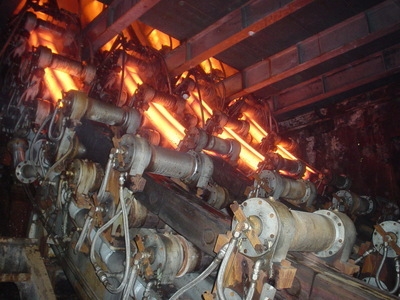ã€China Aluminum Network】 Because the ordinary hard aluminum alloy tensile strength between 380-450Mpa, almost double the tensile strength of ordinary cast aluminum alloy, and superhard aluminum alloy strength up to 600Mpa. Although the unit price of the deformed aluminum alloy is higher than that of the cast aluminum alloy, the forming cost is higher than that of the casting process. However, due to the significant reduction of the product structure size, it is possible to carry out further heat treatment strengthening, welding and surface anodizing treatment. The cost-effectiveness is obviously higher than the former, so more and more occasions, you want to use or change the use of deformed aluminum alloy production parts. For the use of sports parts, such as aircraft, ships, auto motorcycles, sports bikes, etc., to reduce the energy efficiency and speed benefits brought about by weight, deformed aluminum alloy has an irreplaceable advantage. Due to the remarkable progress of the continuous casting and forging technology, the deformed aluminum alloy blanks, which are as complex as the die casting structures, can be produced very easily and smoothly at a similar workshop cost. Therefore, the use of deformed aluminum alloys replaces the traditional production of cast aluminum alloys. The rough, not only has economic advantages, but has become a trend and trend. 1 The basic conditions and performance comparison of cast aluminum alloy and deformed aluminum alloy 1.1 Industrial aluminum ingots are divided into two major categories: cast aluminum alloys and deformed aluminum alloys. In general, cast aluminum alloys are suitable for producing aluminum castings by casting methods, while deformed aluminum alloys are suitable for producing aluminum products by pressure processing (extrusion and forging) methods. 1.2 Deformed aluminum alloys include: rust-proof aluminum (LF), hard aluminum (LY), ultra-hard aluminum (LC), wrought aluminum (LD), and special aluminum (LT). Because the average mechanical properties of deformed aluminum alloys are always higher than that of cast aluminum alloys (forging properties of cast aluminum alloys, on average, are more than a few percent higher than their as-cast properties), many grades of deformed aluminum alloys can also be passed through quenching and aging. Heat treatment means are used to improve the mechanical properties. Therefore, industrial design is expected to use more deformed aluminum alloys to meet the requirements for use. 1.3 The two factors limit the application range of the forged aluminum alloy or weaken its industrial economy: One is that the deformed aluminum alloy has poor casting properties, and its liquid flowability is generally only one-third that of the cast aluminum alloy. It is difficult to produce a structurally complicated blank using a conventional casting method. Second, even if the deformed aluminum alloy blanks are produced by a casting method, if the shrinkage shrinkage and pinhole defects common in the casting process cannot be solved, the subsequent heat treatment and surface anodizing processes cannot continue. The more fundamental reason is that the as-cast deformed aluminum alloy blanks, even if their internal defects are eliminated, are coarse and have a dendrite shape, and the performance after heat treatment is also greatly reduced, or they are only similar to ordinary cast aluminum alloys. The use of this relatively expensive material species has lost its economic importance. However, the emergence of continuous casting and forging technology has effectively changed this situation. 2 Continuous casting and forging technology Continuous casting and forging technology, which refers to the use of the same set of molds in the same equipment, continuous filling and forging production of blanks, its essence, is a process technology that depends on the function of equipment. Therefore, different continuous casting and forging equipment have different continuous casting and forging subdivision processes. 2.1 Continuous casting and forging equipment, according to the device placement, can be divided into horizontal and vertical, according to casting to soup, it is divided into cold room and hot room. Continuous casting and forging process, according to the number of equipment installed forging cylinder, can be divided into one-way continuous casting and forging and multi-directional continuous casting and forging two categories. 2.2 Two typical continuous casting and forging processes and equipment: one is invented by the Soviet Union, the use of hydraulic machines to complete the "liquid metal forging" (or "spray forging"), and the other is the use of our country Invented patent technology to achieve the "pressure casting die forging" (or "squeeze die casting die forging" - referred to as "die casting die forging"). Corner Wheels ,Corner Casters,Corner Mount Casters,Corner Caster Wheels VOLO silent wheel , https://www.volowheels.com